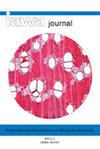芸香科一个大型开普谱系——薯蓣属的木材解剖
IF 3.5
3区 农林科学
Q2 FORESTRY
引用次数: 2
摘要
部落Diosmeae(芸香料)包含大约278个物种分类在11个属:十特有的灌木植物区角(南非),而唯一的树木状的属(两种)延伸从南非到坦桑尼亚。对薯蓣属9属21种的木材结构进行了研究,并对其生活形态和气候生态位进行了分析。所研究的分类群具有整个科的一系列典型特征:放射状的血管多瓣、简单的穿孔板、微小的隔生血管间凹、明显有边界的血管-射线凹、不间隔的libriform纤维和(除Empleurum外)边缘轴向薄壁。然而,与大多数芸香科不同的是,它们偶尔也有边界缩小的管状射线坑。大多数被研究的树种在木材结构和习性上都非常相似。两个例外是Calodendrum capense(唯一正在研究的冠层树)和Empleurum uniccapsulare(一种大型河岸灌木)。前者与其他物种的不同之处在于具有更宽的血管、更长的线状纤维、射线细胞中的棱柱状晶体和翼形轴向薄壁组织(对该部落来说可能是半形的);后者是独特的,因为它缺乏生长环和带状轴向薄壁组织。通过对解剖-气候关系的分析,我们发现灌木薯蓣的木材解剖与它们的大小和环境因素有关,而不是与分类有关。特别是,在从半干旱的冬季-干燥气候到地中海冬季-潮湿气候的梯度上,随着更严格的水量限制,船舶群的增加微弱。本文章由计算机程序翻译,如有差异,请以英文原文为准。
Wood anatomy of the tribe Diosmeae, a large Cape lineage of Rutaceae
The tribe Diosmeae (Rutaceae) encompasses circa 278 species classified in 11 genera: ten of them are shrubs endemic to the Cape Floristic Region (South Africa), while the only arborescent genus (two species) extends from South Africa to Tanzania. We examined the wood structure of 21 species representing nine genera of Diosmeae and analysed it with respect to their life form and climatic niches. Studied taxa share a suite of traits typical for the whole family: radial vessel multiples, simple perforation plates, minute alternate intervessel pits, distinctly bordered vessel-ray pits, non-septate libriform fibres, and — except for Empleurum — marginal axial parenchyma. However, unlike most Rutaceae, they also occasionally feature vessel-ray pits with reduced borders. Most of the studied species are very similar to each other in their wood structure and habit. The two exceptions are Calodendrum capense (the only canopy tree under study) and Empleurum unicapsulare (a large riparian shrub). The first differs from other species in having wider vessels, longer libriform fibres, prismatic crystals in ray cells and winged-aliform axial parenchyma (which may be plesiomorphic for the tribe); the latter is distinctive because it lacks growth rings and banded axial parenchyma. Analysing anatomy–climate relationship, we found that wood anatomy among shrubby Diosmeae relates to their size and environmental factors, rather than taxonomy. Particularly, the vessel grouping weakly increases with stricter water limitation along the gradient from a semi-arid winter-dry climate to a Mediterranean winter-wet climate.
求助全文
通过发布文献求助,成功后即可免费获取论文全文。
去求助
来源期刊

IAWA Journal
农林科学-林学
CiteScore
3.40
自引率
15.80%
发文量
26
审稿时长
>36 weeks
期刊介绍:
The IAWA Journal is the only international periodical fully devoted to structure, function, identification and utilisation of wood and bark in trees, shrubs, lianas, palms, bamboo and herbs. Many papers are of a multidisciplinary nature, linking
 求助内容:
求助内容: 应助结果提醒方式:
应助结果提醒方式:


